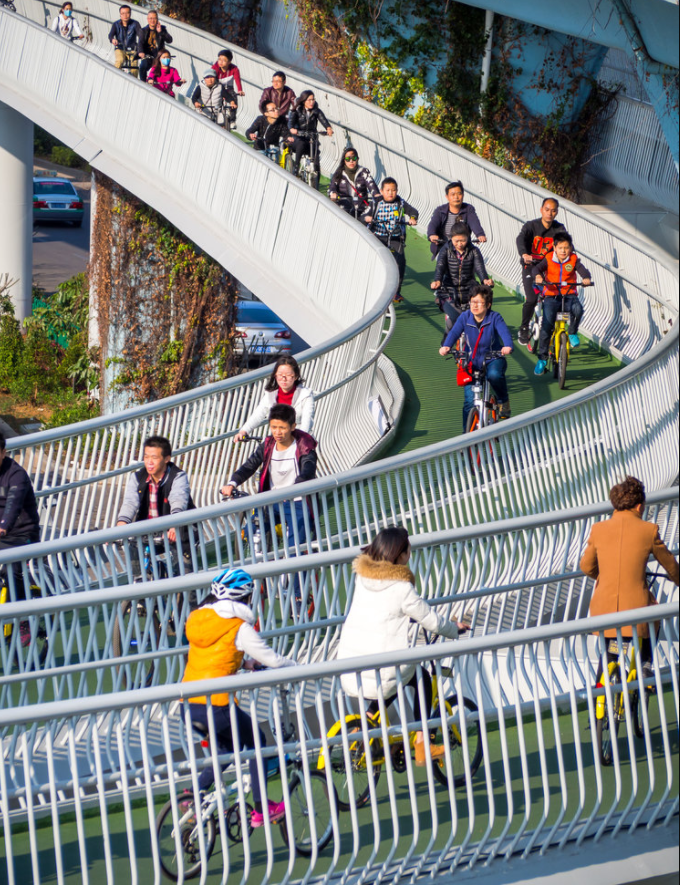China has just built the world’s longest elevated cycle path
We’ve heard of Beijing’s nine million bikes and China referred to as the “Kingdom of Bicycles”. But the reality in many Chinese cities is that the car is king, and getting from A to B has become increasingly difficult – and dangerous – for the country’s cyclists.
However, the emergence of popular bike-sharing schemes, frustration with gridlocked roads, and efforts to tackle the country’s air pollution crisis are all helping to rekindle China’s love affair with cycling.
The southeast city of Xiamen has gone even further with the construction of a 7.6km elevated skyway for bikes – the world’s longest elevated cycle path.
image: Dissing + Weitling Architecture
Connecting the major residential and business sectors of the city, the aerial cycleway sits below Xiamen’s existing overhead bus transport system. At 4.8 m wide it has capacity for over 2000 bikes at a time, and will join up with 11 bus stations and two subway stations. As well as space to park bikes, it will also have bikes available to hire.
Image: Dissing + Weitling Architecture
Designed and completed in six months, the project was the latest in a number of raised cycleways by Danish architects Dissing+Weitling. Another project, the ‘Bicycle Snake’, was completed in 2014. The 230 m bridge connects Copenhagen’s harbour area to the city.
Copenhagen had already cemented its status as a bike-friendly city with a cycle super-highway that connects the city with the suburban town of Albertslund, 22 km away. The eventual aim is to build a network of 28 cycle superhighways, covering 500 km. It is estimated the network will increase the number of cycle lanes in Greater Copenhagen by 15% and reduce public expenditure by €40.3m annually thanks to improved health.
Image: Foster + Partners
Meanwhile, London is among other cities considering proposals for elevated bike paths. Architect Norman Foster unveiled plans to create a 220 km car-free cycle network around the city and surrounds. The city has already introduced a network of cycle superhighways on roads.
Please find the original article here
Written by Charlotte Edmond, Formative Content.
--Future of Construction 10:34, 20 Oct 2017 (BST)
[edit] Related articles on Designing Buildings Wiki
Featured articles and news
How can digital twins boost profitability within construction?
A brief description of a smart construction dashboard, collecting as-built data, as a s site changes forming an accurate digital twin.
Unlocking surplus public defence land and more to speed up the delivery of housing.
The Planning and Infrastructure bill oulined
With reactions from IHBC and others on its potential impacts.
Farnborough College Unveils its Half-house for Sustainable Construction Training.
Spring Statement 2025 with reactions from industry
Confirming previously announced funding, and welfare changes amid adjusted growth forecast.
Scottish Government responds to Grenfell report
As fund for unsafe cladding assessments is launched.
CLC and BSR process map for HRB approvals
One of the initial outputs of their weekly BSR meetings.
Architects Academy at an insulation manufacturing facility
Programme of technical engagement for aspiring designers.
Building Safety Levy technical consultation response
Details of the planned levy now due in 2026.
Great British Energy install solar on school and NHS sites
200 schools and 200 NHS sites to get solar systems, as first project of the newly formed government initiative.
600 million for 60,000 more skilled construction workers
Announced by Treasury ahead of the Spring Statement.
The restoration of the novelist’s birthplace in Eastwood.
Life Critical Fire Safety External Wall System LCFS EWS
Breaking down what is meant by this now often used term.
PAC report on the Remediation of Dangerous Cladding
Recommendations on workforce, transparency, support, insurance, funding, fraud and mismanagement.
New towns, expanded settlements and housing delivery
Modular inquiry asks if new towns and expanded settlements are an effective means of delivering housing.
Building Engineering Business Survey Q1 2025
Survey shows growth remains flat as skill shortages and volatile pricing persist.




























